Cinematic Vampires: From Shadows to Spotlight
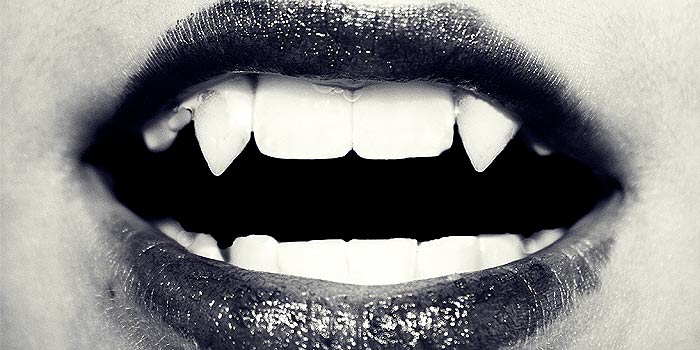
Defining the vampire
The vampire is a creature of popular legend, and one that has fascinated countless cinema-goers for more than one hundred years. Vampires have been featured in folklore and fiction in various cultures. 1 Their characteristics have varied, their name has even varied, but predominantly the myth has centred on the need of these unnatural creatures to consume human blood. 2 Akin in many myths to ghouls, zombies, or other undead, the vampire has always been connected to death. As part of this they have often been associated with concepts of taboo or liminality. They are creatures that conjure a mix of reverence and fear; they represent immortality but only through unnatural existence. They will live forever, but always as monsters. As such the vampire is considered a liminal character, understanding that liminality is the temporary state between two fields, as it removes the borders between life and death. 3 The symbolic desecration of the mortal border of existence crosses an essential line. For the vampire to feed it must take the life force and blood of a living human – a fundamental violation of our belief in the sanctity of life. It is then not a long step to the association of vampires with other immoral transgressions. As such, even in early mythology there have been clear connections between vampires and deviant sexuality. More often portrayed through the breaking of basic Christian values, such as sex outside marriage or multiple partners, it has also been presented as a façade for necrophilia or other forms of bondage, blood play, etc. that are not usually considered part of mainstream society. The vampire in many ways represents the other, the counter-cultural norms of the society in which its myths appears. This continues to hold true in Western cinema’s portrayal of the vampire. One of the great things about cinema, and especially the horror genre, is that as times change and societal fears evolve, so too has the representation of the monstrous vampire. 4
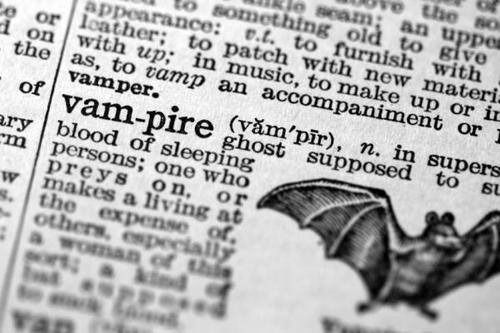 The associated characteristics of the vampire have also varied greatly. Some rise from their graves, or sleep in a coffin, others are more ethereal in nature. They may appear as grotesque monsters or as preternaturally beautiful, an allure to the unwary. 5 Their very creation even differs widely: a person may be bitten by a vampire to become one; some form of sorcery or witchcraft; a contagion carried in blood or other bodily fluids; a ritual process involving particular items; some even believed that babies born with teeth were predisposed to becoming vampires. 6 Even the form of their destruction differs widely: a wooden stake through the heart; fire; decapitation or “taking the head and the heart,” or more detailed dismemberment; or exposure to sunlight or more specifically UV light. 7 The specifics of the creation and destruction of vampires is often unique to a particular fiction, and more elaborate specifications have continued to appear, which is part of the appeal – that it is not a static myth.
The associated characteristics of the vampire have also varied greatly. Some rise from their graves, or sleep in a coffin, others are more ethereal in nature. They may appear as grotesque monsters or as preternaturally beautiful, an allure to the unwary. 5 Their very creation even differs widely: a person may be bitten by a vampire to become one; some form of sorcery or witchcraft; a contagion carried in blood or other bodily fluids; a ritual process involving particular items; some even believed that babies born with teeth were predisposed to becoming vampires. 6 Even the form of their destruction differs widely: a wooden stake through the heart; fire; decapitation or “taking the head and the heart,” or more detailed dismemberment; or exposure to sunlight or more specifically UV light. 7 The specifics of the creation and destruction of vampires is often unique to a particular fiction, and more elaborate specifications have continued to appear, which is part of the appeal – that it is not a static myth.
The mythos connected to raising the dead already occupies a place of deep unease in Western Christian society. Connected from a Christian view to the story of Jesus and the saints, it appears often as a strong perversion of divinity. The other legends of the dead rising commonly used in fiction today derive from Vaudun or voodoo traditions. Every culture, religion and time has a set of beliefs regarding the ability to raise the dead. It is a fundamental desire of humankind to be able to find a way to restore our departed. The vampire is part of the warning that such unnatural desires can have terrible consequences. Creatures bearing vampiric characteristics that attack those sleeping and drain their blood, have appeared as far back as ancient Greece. 8 Some of the earliest recorded vampire fables were composed in Sanskrit in the 730s CE. 9 Walking corpses that drank the blood of the living were a common part of folklore in medieval Europe in times of diseases. 10 Such tales were particularly popular in Eastern Europe, and many writers today still draw from these myths, and the original base word for vampire is believed to have been derived from there. 11 The first known recording of the root word was in a Russian document referring to a prince as an “upir lichy” or wicked vampire. 12 The word “vampyre” did not enter the English language until around the 1730-40s with the first modern vampyre poem ‘Der Vampir’ being published in 1748. 13
It is from here, when the concept of the vampire entered English language that we see the most direct correlations to the Western cinematic representations of the vampire. In 1819 John Polidor wrote ‘The Vampyre,’ which was the first recorded vampire story published in England. In 1872 Irish writer Joseph Sheridan Le Fanu published the novella Carmilla, a tale of a young vampire girl adopted into a family after a carriage accident. Although befriending the family’s daughter, Carmilla begins to kill other girls in the area. Eventually a vampire hunter comes and exhumes the body of Carmilla and stakes her through the heart. Although it predates Dracula by thirty years it draws on a number of similar concepts and mythologies. It was during this period of Gothic literature that the tale of the vampire flourished in publications. The 18th and 19th centuries were the peak of the modern incarnation of the vampire myth. The most famous work of this period being Dracula by Bram Stoker that was published in 1897. 14 The tale of the Transylvanian count with supernatural abilities that comes to London, solidified many of the popular concepts of vampirism that appeared in the earliest cinematic portrayals, especially in Nosferatu and Bela Lugosi’s portrayal in Dracula. Before examining the prevailing popularity of the vampire myth it is worth examining how (a key selection of) the cinematic portrayals of the vampire have moved from the shadowy figure in black to the enigmatic creature in the spotlight.
The 100 years cinematic timeline
1910s
1913 Vampire
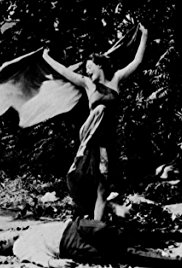
The earliest believed cinematic appearance of a vampire was in Robert G. Vignola’s 1913 black and white silent film, tilted The Vampire. It was loosely based on a Rudyard Kipling poem and featured the vampire as a femme fatale. 15 It was only one among twenty five silent films to use the term vampire. A film titled Vampire of the Coast (1909) was the earliest use of the term in the title, but the film was about pirates. 16 There is much confusion surrounding the film The Vampire as very little survived of the film and its details. It could in fact not be about vampires, but rather be utilising the word to mean a villain or unsavoury character. 17 The term, in fact, was also used in this early period to describe a woman who uses her charms to seduce a man. 18 What made this film suggestive that it was the first presentation of a cinematic vampire was its connection to Kipling’s poem ‘The Vampire’ (1897). 19 The plot of the film has been roughly preserved and tells the story of a woman in India who kills a hunter. When the hunter’s friend shoots her she turns into a snake woman. 20 Mythology from India alleged that vampires could take the form of various animals. As such if this is to represent the first version of the cinematic vampire it sets some interesting precedents: the vampire as a woman (which relates back to the early story of Carmilla), and the vampire as a shape-shifter.
1920s
1922 Nosferatu
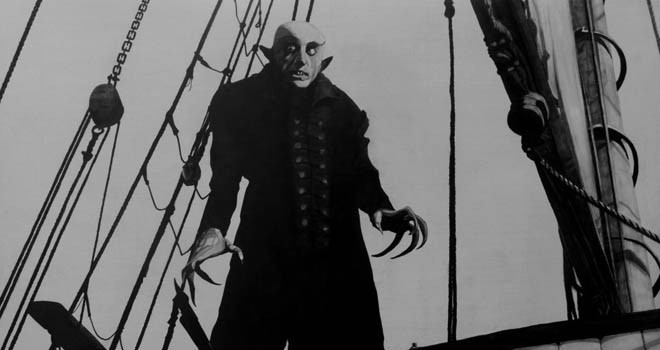
For most, however, it is the 1922 film Nosferatu that is perceived as the first true vampire film, and for good reason. 21 Nosferatu, still a silent movie, was a more sophisticated cinematic piece and introduced the atmosphere of terror. 22 Brought to the screen by F.W. Murnau, whose direction saw a film of shadows and angles that captured the unreality of this psychological thriller. 23 The central vampire was not Dracula, but was instead known as Count Orlok, acted by Max Schreck. In many ways the portrayal of Orlok is the closest to the original myths and folklore. Orlok was not an appealing seducer, but rather he is a monster: a nightmarish apparition, with a bulbous bald head, deathly white skin, batlike ears and long talonlike fingers. 24 He appears on screen as less than a man, with a stammering walk and overly elaborate movements of his taloned hands. He is a literal representation of what the vampire represents. He is death, decay and a parasite feeding on humans. He feeds on many, bringing death and rats with him on his ship to London, a supernatural and literal plague. He rests through the day in a coffin and feeds at night, with his undoing being a beautiful woman who can distract him through the night. Orlok is defeated not by a hunter, but by his own greed to feed, and when the sunrises and a rooster crows he turns to smoke. This vampire is closer to the monstrous myths of the bloodsucker, the zombie, the ghoul that early authors would have been aware of. He is other, the unnatural and to be only feared.
1930s
1931 Dracula
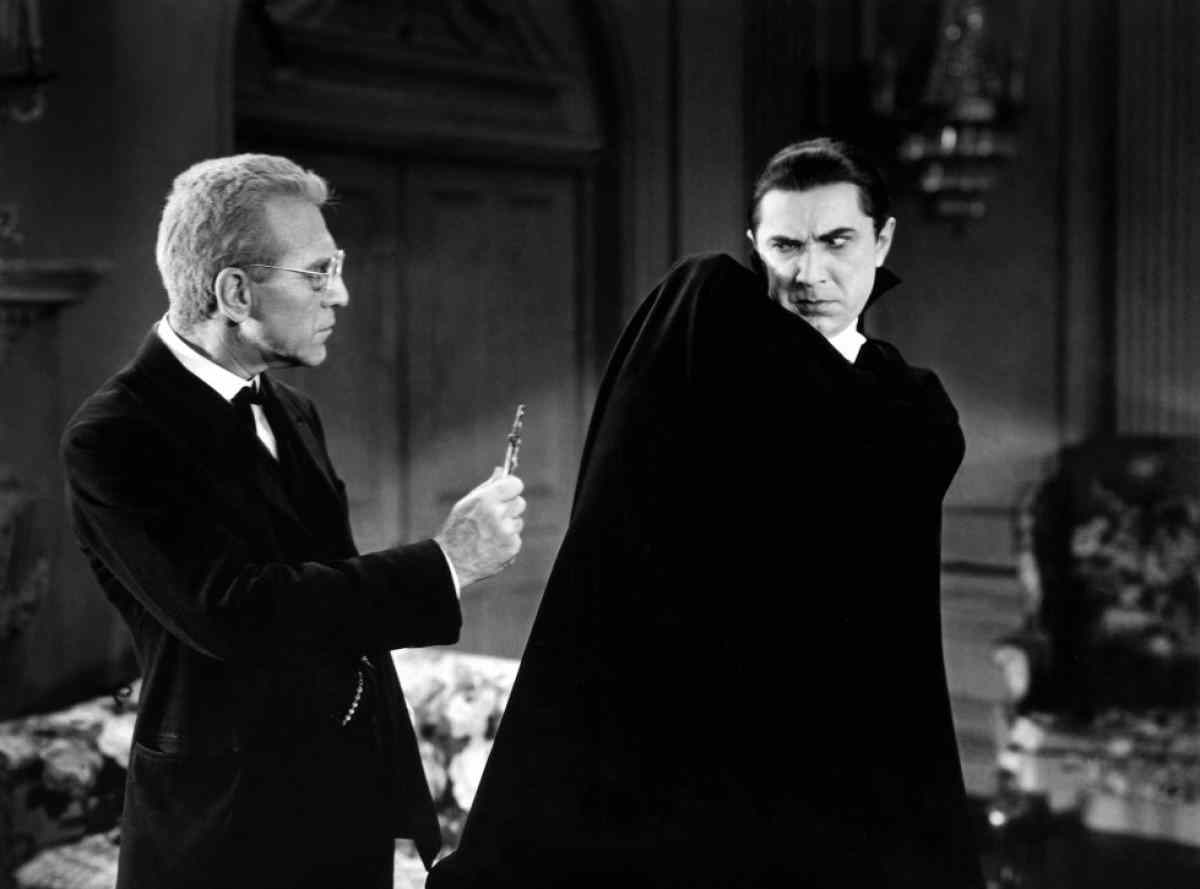
The introduction of Count Dracula and the iconic imagery associated in popular culture began here in 1931 with Tod Browning’s film Dracula. 25 Similar to Stoker’s version, it is actually a derivation based on a 1924 stage play. 26 The Dracula presented is the well-groomed, suave man with a black cape and fangs. It was also the first true horror movie American audiences experienced where filmmakers did not minimise the terror onscreen (only three years later a code system was implemented). 27 Dracula was portrayed by Bela Lugosi, one of the best known actor-vampires and who became typecast into this role for the rest of his career. Lugosi had already been undertaking the role of Dracula, having performed the part for 40 weeks on Broadway and years on the road. 28 He was popular in the role and presented the vampire as a mesmerising gentleman as far at odds with Stoker’s intention as Orlok was, yet he drew on an aspect of Dracula that was absent in Nosferatu: that of the compelling immortal. 29 He is also a fairly powerful version, able to shape-shift into a bat, hypnotise with a gaze, and turn others to vampires with his bite. He is able to create his servant Renfield to protect him, giving him a taste for blood in the form of insects and small creatures. He is also given weaknesses: he casts no reflection in mirrors, must rest during daylight, and is killed by the impaling of a wooden stake. This representation of the vampire was a tremendous success, and so cemented a new portrayal. Lugosi played the role to emphasise the vampire as a gentleman, a noble of exotic history, well-dressed and charismatic.
1932 Vampyr
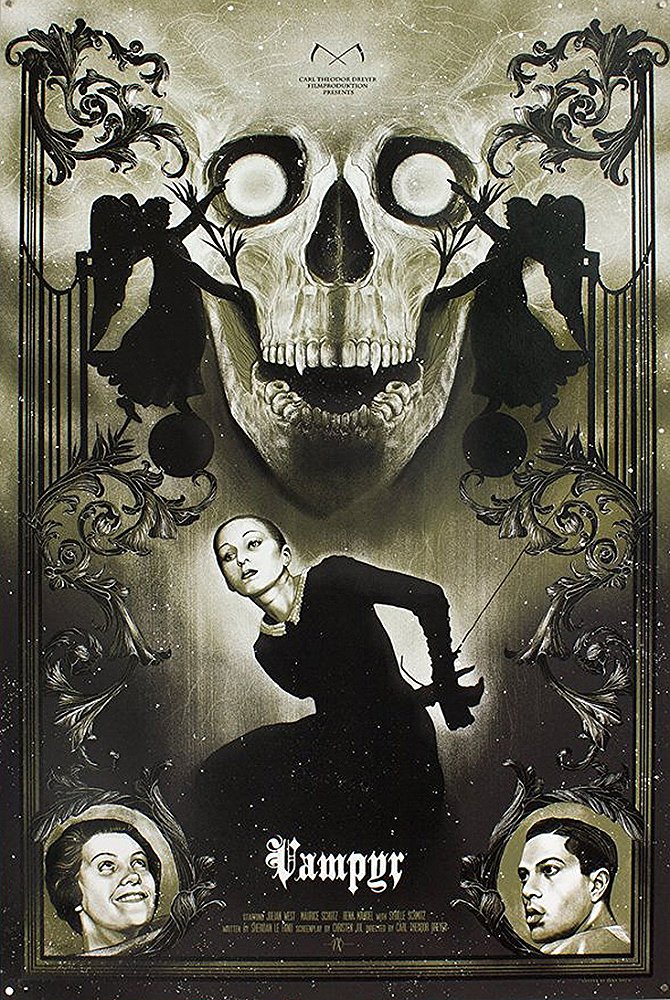
A much lesser known film of the period is Vampyr, directed by Carl Theodor Dreyer and released in 1932. A story separate to Stoker’s, it nonetheless returns to Le Fanu’s female vampire. The plot follows the death of a lord, who confides in a visiting occultist Allan Gray, and bequeaths him a book on vampires. 30 Grey then solves the murder, uncovering that local dowager vampire Marguerite Chopin is in control of the town before killing her. The story clearly draws on Le Fanu’s Carmilla, but is a slightly “cleaner” version without the implied lesbianism, and with an emphasis on the vampire’s ability to turn family members against each other. 31 The vampire conforms to traditional female vampire stories in literature and early film, where it is less about abilities and more the insidious nature of the vampire.
1936 Dracula’s Daughter
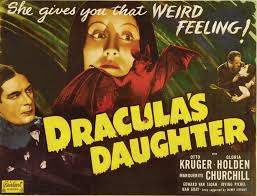
Directed by Lambert Hillyer, the 1936 Dracula’s Daughter is a sequel to Dracula and begins a few moments after the previous film on Dracula’s death. 32 The story focuses on Dracula’s daughter, Countess Marya Zaleska, who steals Dracula’s body and burns it in the hope it will make her mortal. Yet this does not quench her thirst for blood and she continues to kill and sleep in her coffin during the day. 33 She eventually seeks help from a psychiatrist, when he fails to help she kidnaps his love and takes her to Transylvania. She is stopped and killed by an arrow. With fewer powers than previous iterations, she is still a similar portrayal of the female vampire, with lesbian undertones also present in the film. While the role of the male vampire continues to evolve and change, unfortunately the female one remains fairly static until much later.
1940s
1943 Son of Dracula
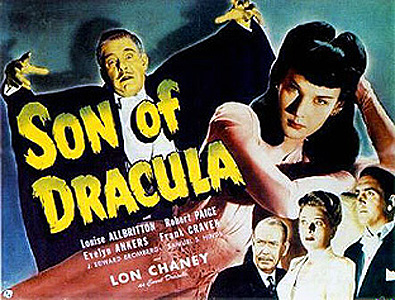
In 1943 the Son of Dracula, directed by Robert Siodmak, followed as a sequel to Dracula’s Daughter and stared Lon Chaney Jr. as the Count Alucard (Dracula spelt backwards) who comes to America. 34 The film is confusingly situated as Alucard is not directly referenced as a son, of Dracula himself, but more a possible descendent or perhaps a “spiritual son.” It is actually a fairly dark film focused on a love triangle. 35 While Chaney’s Alucard followed well in the footsteps of Lugosi’s Dracula, he brought to the performance a menacing air, still a gentleman, but a noticeably more dangerous one with none of the suave European airs or accents that Lugosi utilised. The story largely is about a normal love triangle, and other than Katherine’s fascination with the morbid there is no suggestion that Alucard had coerced her into the relationship. In fact his only display of power is being insubstantial when Katherine’s boyfriend, Frank, shoots him, causing the bullet to pass through to strike and kill Katherine instead. 36 Alucard turns Katherine and they sleep in the day and hunt the town at night. Katherine, however, wants to share immortality with Frank and tells him how to kill Alucard, which he does before also setting Katherine’s coffin on fire. Alucard is destroyed by the rising sun when he no longer has his resting place, continuing a similar theme to Nosferatu in the killing of vampires.
1948 Abbott and Costello Meet Frankenstein
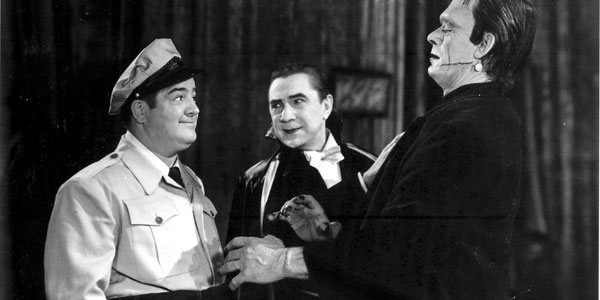
A deviation from the horror films is the 1948 horror/comedy Abbott and Costello Meet Frankenstein. 37 The inclusion of this film is as the first comedic cinematic presentation of the vampire, and Lugosi appears as Dracula. This is an incursion of where the character is used as a caricature, a cultural icon of what the vampire is: black caped, slick, gentlemanly and blood thirsty. It is interesting as it represents the embedding of iconography in relation to a particular version of the vampire. It is also an early concept of drawing the vampire outside of belonging to horror alone.
1950s
1958 Horror of Dracula
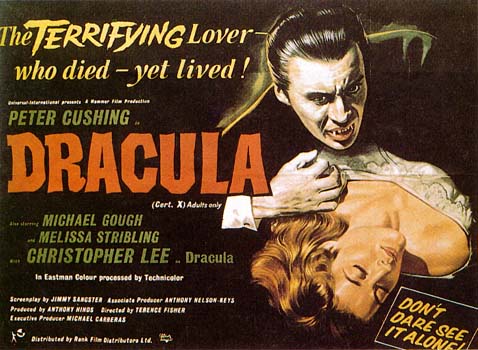
The next important cinematic portrayal of Dracula is in the self-same titled film that starred Christopher Lee in the titular role (known as Horror of Dracula in America). Directed by Terence Fisher, the film also launched the Hammer Horror franchise of films, and was the British answer to the American films. 38 It was also the first version of Dracula in colour. 39 But more importantly, it introduced the final nuance to the most commonly known version of the vampire: the lover. 40 Lee’s depiction was the first to bring vampires out of the shadows. He was not lurking in the dark waiting for the victims to come to him, but rather was a sophisticated, charismatic hunter that offered a dangerous and irresistible allure to the unwary. The narrative is based again on Stoker’s novel, but with considerable alterations to the plot. The story focuses on a vampire hunter (Jonathan Harker trained by Doctor Van Helsing) who comes, disguised as a librarian, to Dracula’s castle but fails. The vampire women who served Dracula are killed in their coffins with a wooden stake to the heart, also the first indication of the brides of Dracula. Dracula in this film easily outwits his hunters, and turns a number of characters to vampires, he is seldom seen onscreen, but this acts to highlight his ability to outsmart the others. 41 Only when Van Helsing traps Dracula in his castle after sunrise does it end by Helsing opening the curtains and forming a cross with two candlesticks to force Dracula into the sun, where he falls to dust. 42 Lee presents a terrifying, but strongly alluring vampire in a film with strong sexual undertones. Aristocratic in his bearing, Lee managed to convey the nobility of the immortal trapped in time, although he brought women under his thrall a certain sadness would come over him, a regret in the circumstances. 43 For the first time Dracula was shown as having vulnerabilities in his character, the misunderstood monster that appealed to women the world over.
1960s
1960 The Brides of Dracula
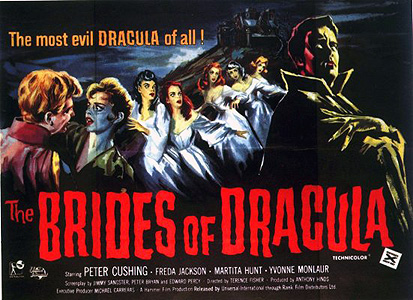
The Brides of Dracula was the next Hammer Horror films. Directed by Terence Fisher again, however, it does not include Christopher Lee as Dracula, but returns to the presentation of the female vampire. 44 The narrative follows a young woman, Marianne, and the young Baron Meinster who was imprisoned by his vampire mother. Both mother and son were engaged in debauchery and turn to a darker nature. Van Helsing again comes to the rescue and stakes the vampires. The film has thinly veiled messages on Christianity and morality, which undermine the vampire narrative. 45 However, it fits in comfortably with the previous female vampire representations, where their power is based in the sexual, the filial and ultimately lead to their own demise rather than “battling” with the hunters. It is also one of the most clearly situated vampire films that leans into the concept of the vampire as evil in the biblical sense.
1964 The Last Man On Earth
While earlier films did star hunters who drove the narrative, they were still films that framed the vampire as The Vampire – a singular character who embodied the immortal power of vampires. In 1964 The Last Man On Earth offered two unique perspectives: the vampire hunter as the central character, and vampires as a collective. Based on Richard Matherson’s 1954 book I Am Legend, it depicts a dystopian world where vampires overwhelm humanity and one man becomes a reluctant vampire hunter. 46 This is important as even though characters such as Van Helsing, especially following Peter Cushing’s outstanding acting, have become as notable as the vampire master himself, this was the first strong cinematic shift to focusing on the hunter. Secondly, the film portrays vampires as zombies, as a plague that mindlessly feasts and destroys. Previously, the secondary vampires in films had been minions, but retained their own personality to a degree. The film also touches, at the end, on a hierarchy existing with more rational vampires hidden away, also an interesting concept seized on later.
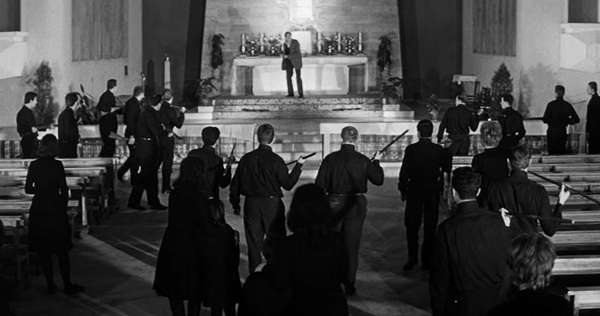
1966 Prince of Darkness

A return to Hammer Horror films was Prince of Darkness in 1966 and a reappearance of Christopher Lee’s Dracula. 47 Dracula is resurrected through dark ritual, a very thought-provoking precedent to set, but ultimately the story returns to drinking from women, and the demise of the Count, this time by drowning. 48 Interestingly, one of most intense portrayals of Dracula that reinforced his nature as the strong and silent type came out of a dislike by Lee of the script. 49 Lee who apparently held Jimmy Sangster’s scripted dialogue in contempt refused to utter a single word in the film and instead only snarled and hissed. 50 Instead of devolving the character back to a monster, it seemed to somehow express Dracula’s dark demeanour, a display of inner turmoil. 51.
1970s
1970 Taste the Blood of Dracula
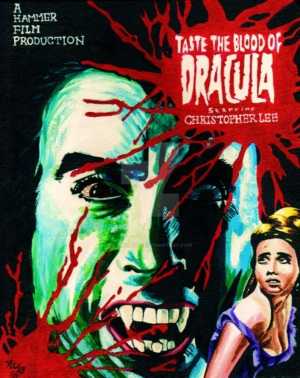
The 1970 continuation of the Hammer Horror films actually follows the 1968 Dracula Has Risen From the Grave, which is largely more the same as above. What Taste the Blood of Dracula signalled was an engagement with explicit sexuality and Christianity. 52 The film displays a woman’s naked breasts for the first time, and the de-sanctifying of a church, plus the undertaking of a satanic ritual to raise Dracula. 53 The sexualisation of the vampire by this stage has become an entrenched concept. But this period also saw the popularity of the reviving of the vampire by numerous means, a premise continued in Dracula A.D. in 1972.
1972 Blacula
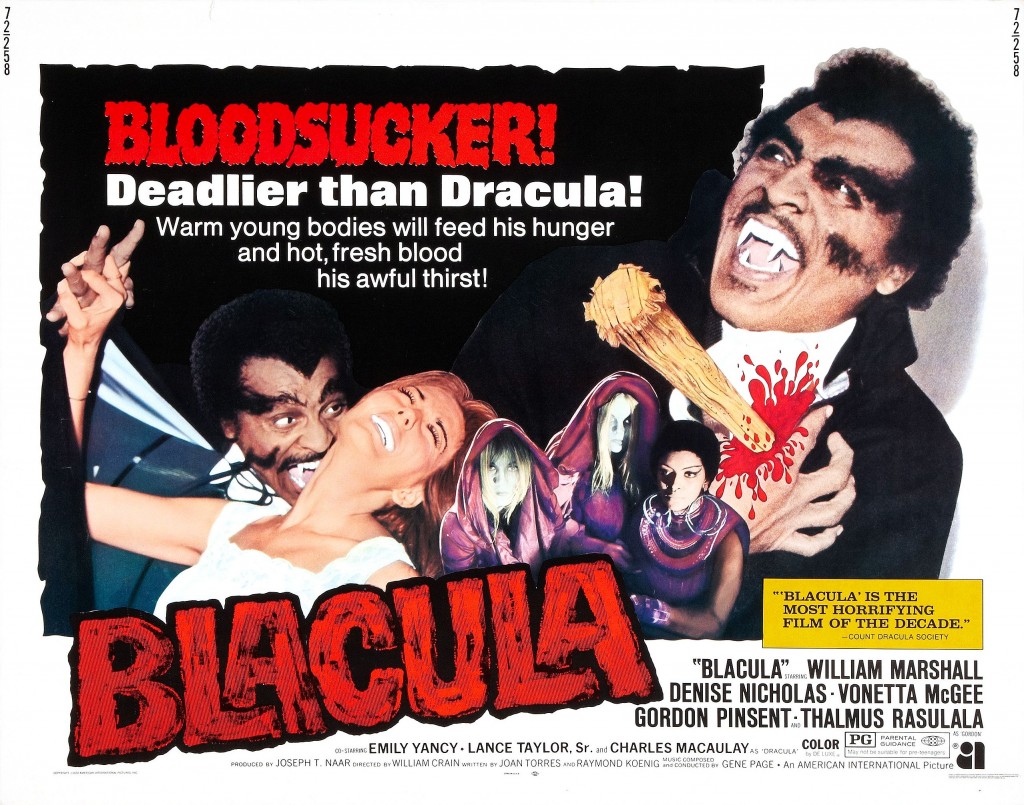
Blacula is a significant shift in the representations, centrally as for the first time the vampire is black, but also for the nuanced portrayal of the vampire. Known as a Blaxploitation horror film, it told the story of Prince Mamuwalde from a fictitious African nation who was sent to seek help from Dracula in ending the slave trade in 1780. He is of course killed and turned, his wife also left to die, and is left in his coffin which is only uncovered in 1970. 54 The film, like many, seizes upon the vampire as a metaphor for colonisation, here Mamuwalde is stripped of his identity and given the name Blacula, separated from his family and warped by the experience. 55 In the opening depiction Mamuwalde is shown to be educated, proud and honourable, which is altered by his transformation into a vampire. The vampire here is then similar to early depictions, he hunts, drinks and makes more, with a focus here on Tina whom he believes to be his reincarnated wife. He cannot be seen on a photo negative, and stakes through the heart kill his minions. Yet at the end Mamuwalde willingly climbs the stairs to the roof to be destroyed by the morning sun, rather than face eternity alone once Tina is killed, the first of the vampire versions to show true remorse, and opt for suicide over continuing as monster.
1979 Dracula
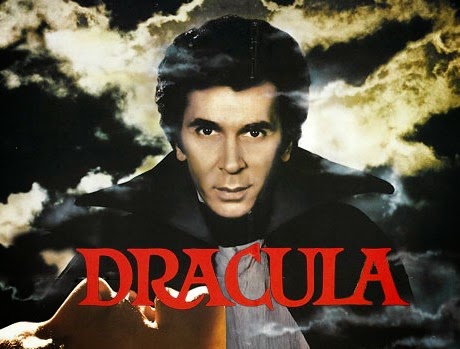
Another remake of Dracula, with the same title is released in 1979 and stars Frank Langella in the lead. However, it deviates in the characterisation of Dracula, making him a seductive and almost compassionate character. 56 Langella is a different version of even Lugosi and Lee’s charismatic vampire. He has no red eyes, or blood dripping from his mouth, and no accent. Yet he is cool, suave, and endlessly charming. 57 He is a prominent protagonist and interacts with the characters in much more detail than previous portrayals. He is charming, seducing Lucy with more than vampiric powers, yet he is also clearly a killer and monster. This is represented less through him then the women. When he brings back Mina it is not as a lush woman, but a dead creature, grey skinned and red eyed. 58 The focus of the film is the romance between Dracula and Lucy, yet the romantic allure of the vampire is made more monstrous by the translation of vampirism in his victims. It is one of the best depictions of the monster beneath the façade of beauty.
1980s
1987 The Lost Boys
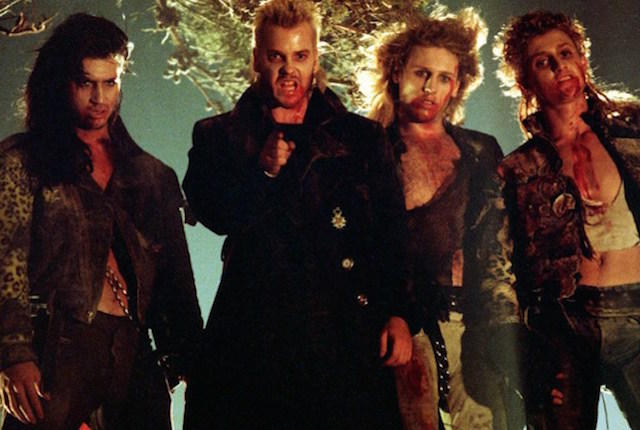
The Lost Boys is the most iconic shift for the cinematic vampire. This introduced the teenage vampire, and has prevailed as one of the strongest cultural shifts in the image of the vampire. Director Joel Schumacher took the myth and made it modern, gone are the castles, capes and middle-aged men. 59 Instead he replaced it with gangs, beach parties and comic book stores. The story emphasises ideas of rebellion, sexuality and fear, within adolescent terms and resonated with audiences. 60 It draws on traditional ideas, with thirst for blood, sensitivity to sunlight, no reflection, can be impaled by a wooden stake, but also adds holy water and garlic (in a bathtub), electrocution, and the concept of initiation. For a vampire to finally turn they must kill and feed. It also introduces two new concepts that have been picked up in a myriad of popular-culture since: the idea that if the head of the vampires is killed this will free the others, and that people know of vampires living in society (this arguably is the shifting of genre, moving vampires from horror/gothic to urban fantasy). The film not only offered teen vampires, but it offered new interpretations and considerations of the mythology, while simultaneously poking fun at the common knowledge of vampires created by decades of pop-culture.
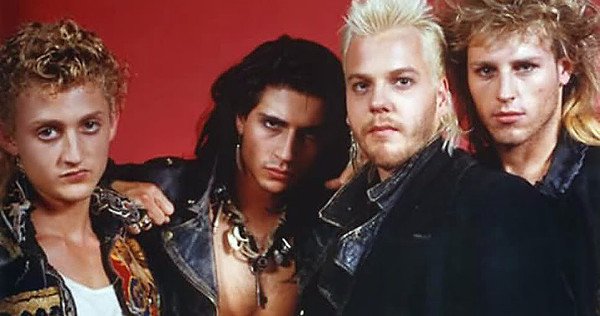
1987 Near Dark
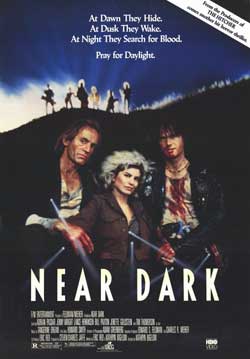
Near Dark, directed by Kathryn Bigelow, is a mashup – a Western vampire movie, and not the only one. It centers on Caleb Colton who is turned by an alluring woman named Mae. He is then brought into her family where he must kill and shed blood. 61 It is a film stripped of the expected gothic trappings, with no crosses, coffins or holy water, but rather involves guns and knives. 62 Sunlight, however, continues to be deadly, as is the need for blood. The film is set amongst abandoned buildings, cheap motels and travel in blacked-out windows, all of which help films such as The Lost Boys in signalling the overall change to the vampire narrative.
1987 My Best Friend is a Vampire
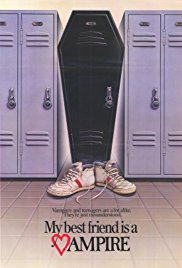
Not the first vampire comedy, but one that again acts as a cross-genre interpretation of the vampire story. My Best Friend is a Vampire, directed by Jimmy Huston, focuses on the idea of a newly made vampire trying to not feed on humans. 63 Not a deep interpretation as it is focused on the teenage problems of the lovelorn Jeremy, but it does hint at later films that deal with the concept of the moral struggle between what is needed to live against the cost to others. Part of the comedy of the piece is the inclusion of traditional concepts: he is turned by an older, sexually appealing female vampire; he develops an aversion to garlic; sensitivity to sunlight; and a craving for blood. 64 He is considered a “living” vampire rather than an undead one, and is even provided with a guidebook that frames vampires as a “minority group” who has been persecuted. 65 It is one of the earliest presentations of the vampire as harmless, “different,” and able to be integrated into human society. The film in fact ends with Jeremy still a vampire, but now one with a girlfriend that he introduces to his parents.
1990s
1992 Bram Stoker’s Dracula
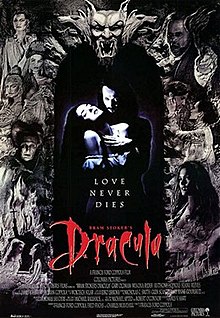
1992 saw the return to Stoker’s Dracula, moving back away from teenage issues and popular culture. Francis Ford Coppola directs Bram Stoker’s Dracula, deliberately connecting the film to the book. It has been widely accepted as an accurate screen representation, but still bears clear amendments to the original version, which is most obvious in his characterisation of the titular lead. 66 Stoker’s Dracula is monstrous, a killer driven by blood, and a representation of England’s fear of the darker mythologies of Eastern Europe. In comparison Coppola chooses to depart from this and follow the progression that had been evolving: of a romantic lead, a misunderstood Byronic hero. Blood lust alone was not the focus to motivate Dracula to pursue Jonathan Harker and Mina Murray, but rather a connection is made to the inspiration of the original story, the historical character of Vlad Tepes (the Impaler), and as such his origins as a man. 67 Where previous versions have focused either on the monstrous or the sexual nature of Dracula, Coppola’s version is more interested in the idea that Dracula is capable of love. 68 It is also presented that he has further abilities, mainly that he is able to change between youth and old age, which also is able to represent the different aspects of his character – the old hermit living as a monster, and the young man who seeks love. It is indeed a romantic representation. The entire film leans into the romantic genre, with a Romeo and Juliet style end, where Dracula lies dying in his chapel where he first renounced his faith, turning young to kiss his love goodbye as the cross above him repairs itself, and he asks her to give him peace, which she does by stabbing a knife through his heart. This version offers three new considerations: the curse of the vampire can be a punishment for turning from god (a thread picked up in many later film and television versions); immortality is not only about being young; and a vampire can seek love.
1992 Buffy the Vampire Slayer
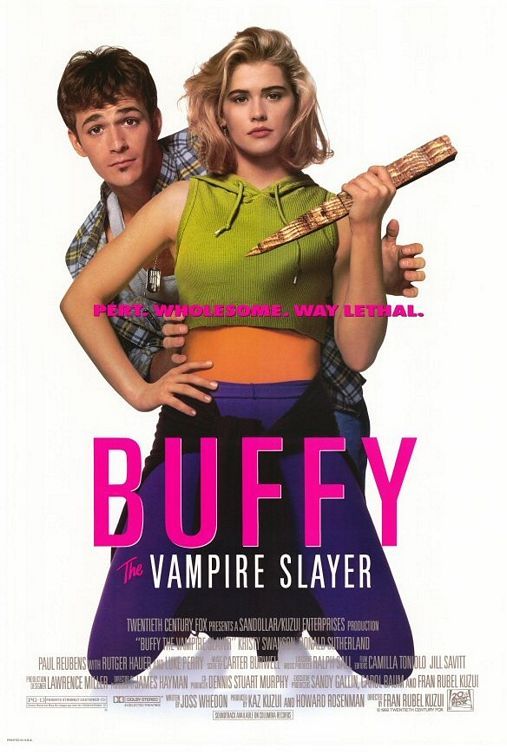
In the same year came Buffy the Vampire Slayer, a continuation of the teenage vampire films with an edge of comedy. It is a strong mix of The Lost Boys, with gang style hierarchy and leather glad vampires, Dracula, with the use of traditional mythology and references to earlier vampire hunting in Europe, and My Best Friend is a Vampire, set in a suburban high school with teenage problems. The film is focused on the vampire slayer, Buffy, who while being a cheerleader is also now following her destiny as a slayer. 69 It lacks the finesse of the later television version, but it does also signal a change for later films, where the focus of the film is on the hunter, not a collective, but a single hero who is holding back the darkness.
1994 Interview with a Vampire

Interview with a Vampire is an adaption from the Anne Rice series and captures a different perspective on the vampire myth. The key difference is that for Rice it is the complexities of an immortal’s tale that is the important narrative, and less focus is spent on the blood lust and staking. These vampires, through the lens of Louis, are tortured characters that struggle with their vampire natures. 70 The film straddles the emerging views of vampires. Lestat is blood hungry, charismatic and throws himself joyfully into an immortal life as a vampire, unrepentantly killing. However, Louis the brooding protagonist, who Lestat turns, struggles with the killing, rejects human blood for rats and continues to fight against the immorality of their existence. Only when Claudia, a child vampire, is made do the two come back together in accord and form a family. 71 The actual invention of Claudia raises some further questions about immortality, with this woman who kills and feeds trapped inside a woman’s body. The film also touches on an emerging sense of sexuality in relation to homosexual relationships. Vampire sexuality has previously centered on concepts of sensuality and lesbianism, only in the support of meeting the male gaze. The advent of new interpretations of the vampire has been used to explore the homosexual experience as part of appealing sexuality.
1998 Blade
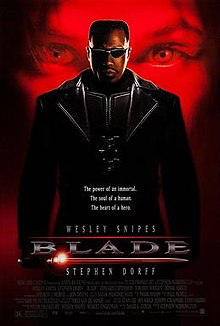
Directed by Stephen Norrington, the action/horror film Blade is the first film version of a comic book vampire, and it has a unique take on the myths. It draws on the similar successes of Blacula and Buffy the Vampire Slayer, in that it subverts the expected. The narrative focuses on the hierarchy of the vampires, and Blade’s unique place as a part-vampire. 72 Originally created in 1973 Blade is a character that hunts his own race. Redesigned in 1998, Wesley Snipes’ presentation as a stoic warrior resulted in a shift in the corresponding comics to reflect his performance. 73 The film picks up on traditional icons: aversion to sun, silver, beheading, staking, etc., but it also introduces the Daywalker, a vampire that through mixed heritage can walk in the sun. It also begins to flesh out the idea of the vampire hierarchy, of leaders, factions, their own lore (Blood God), connections to human politicians, willing human donors, and levels of power and prestige, including an obsession with pure-blood vampires (the nobility). 74
2000s
2003 Underworld
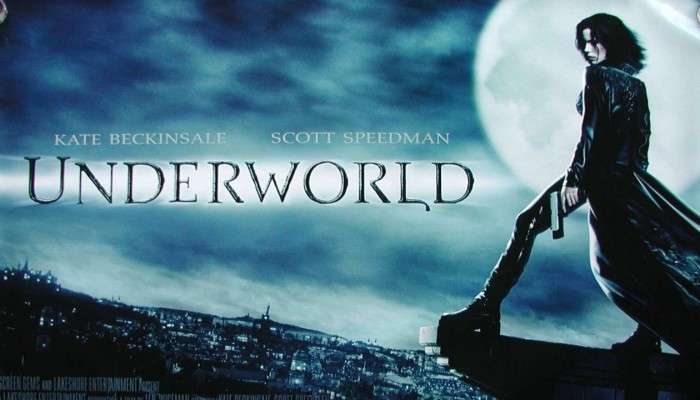
It is fitting to discuss Underworld next as it picks up many of the concepts Blade put into play. Directed by Len Wiseman, Underworld is a film about the war between vampires and lycans (werewolves). The central character Selene is a trained assassin, a vampire, that hunts the lycan. 75 This feud has been going on for centuries and largely occurs outside human purview, yet when Selene becomes mixed up with Michael Corvin who is turned into a lycan the film delves into a moral shift that sees Selene realise the injustice present in the vampire’s persecution of the lycans. Selene undergoes a huge transformation, which highlights the complexity and depth of the vampire. It is also the first presentation of a strong female vampire that is not sexual or debauched. The film manages to tell an incredibly dense set of lore (largely reliant of a viewer’s base understanding of vampires and werewolves) along with a star-crossed lovers plot, while framing the vampire as a supernatural powered being, but still bound by morals and ethics. 76
2008 Twilight
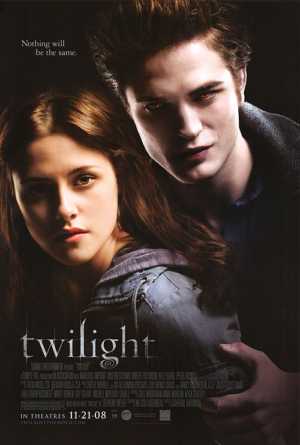
Twilight based on the Stephanie Meyer’s book was directed by Catherine Hardwicke and offered a fairly accurate representation of the source material. Again, a teenage vampire interpretation, but with some changes in lore (mainly in the form of the beautiful sparkling vampire). The film also does not belittle the role of humans, and ends without the female losing her life or becoming a vampire. The intense sexuality is present, but repressed, and the vampire is still positioned as a sexual threat. These vampires subsist on animal blood, but display superhuman strength, supernatural powers and resilience. 77 Hugely criticised, what Twilight did offer was the framework to understand that all aspects of the mythology are amenable for narrative impact, without losing the presence of the vampire.
2008 Let the Right One In
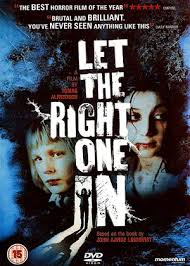
Let the Right One In delves into the unsettling idea of the child vampire. Based on the 2004 novel by John Ajvide Lindqvist, it is directed by Tomas Alfredson and sits firmly in the thriller genre. The story focuses on the developing relationship between human boy Oskar, who is significantly bullied, and child vampire Eli. The brutality of Eli’s killings of adults is horrific and in line with expected vampire feedings, but is further terrifying for audiences when witnessing her frail, childish form attack larger male characters. The film borrows from vampire traditions (avoid sunlight), but largely highlights the potential violence of children. 78 Eli is vulnerable, but monstrous in a manner that cannot be expressed by adult versions of the vampire myth. With a plethora of film and literary versions before it, even the most jaded of vampire-viewers would struggle not to be unnerved by this iteration.
2010s
2013 Byzantium
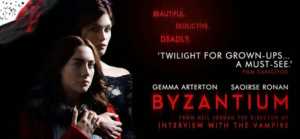
Directed by Neil Jordon, Byzantium, is a unique story about a vampire mother and daughter on the run from the brotherhood of vampires. 79 The film also rejects all the traditional weaknesses and strengths of the vampire, retaining only the need for blood. Furthermore, the key lore of the film is that vampirism is gained by finding a hidden waterfall on a remote island. 80 The film centers on the mother/daughter relationship and the issue of isolation and secrecy. 81
2014 Only Lovers Left Alive
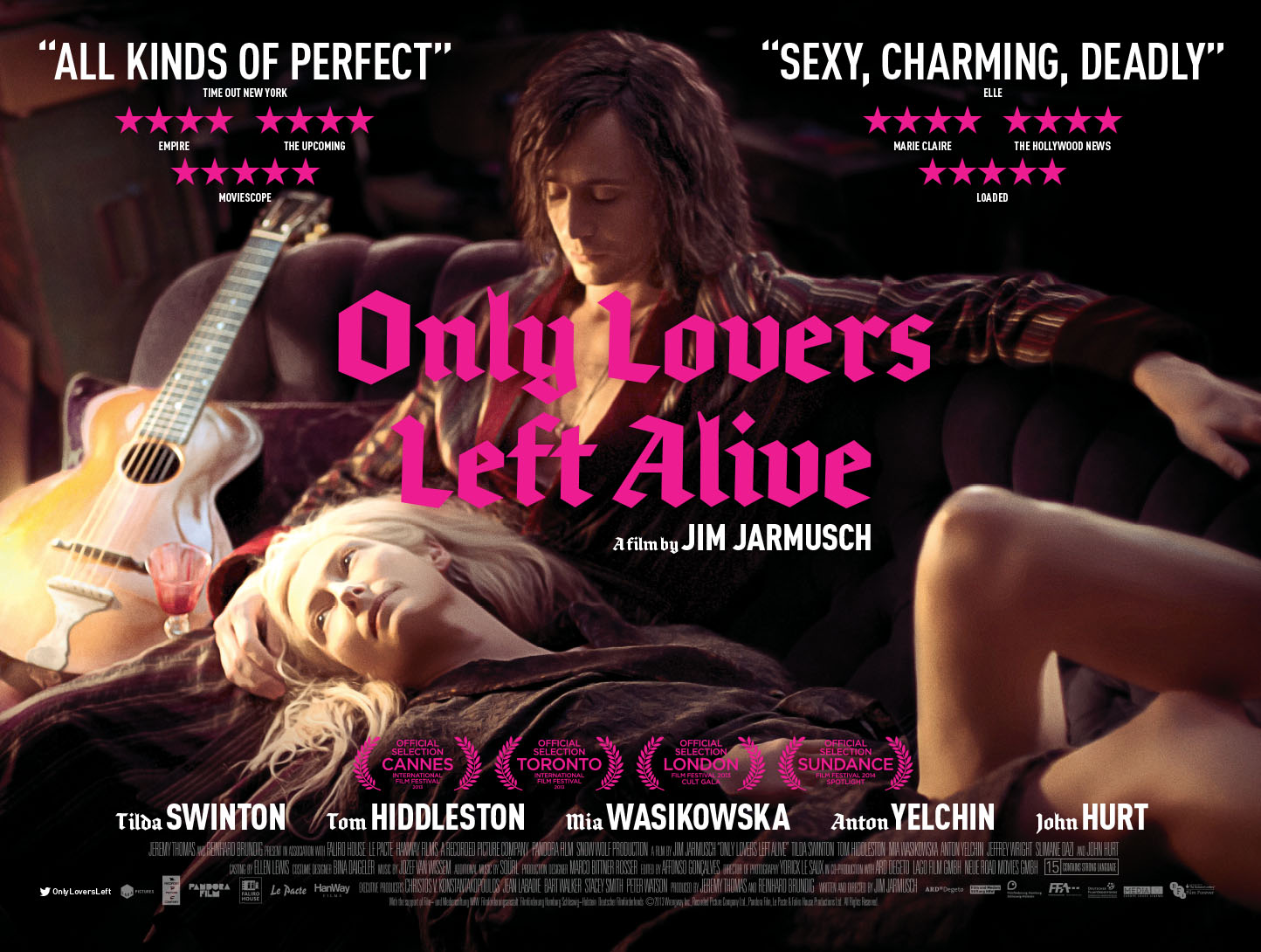
Only Lovers Left Alive continues with the new perspectives of the vampires. Created by Jim Jarmusch, it is a film more about art than love. The film touches on one of the greatest appeals of the vampire: immortality. It highlights that vampirism is a way to be there to see the turning of history, the changes to culture and to bear witness to new societies. 82 It explores the darker psychology of immortality, as Adam (male vampire) laments the heartlessness of humans. 83 The film touches on the hunting of the vampires as through centuries they have been pursued, but focuses more on the fatalism of living an eternal life in a diminishing world. 84
2014 Dracula Untold

Returning to Dracula, the 2014 film created by Gary Shore, Matt Sazama and Burk Sharpless, Dracula Untold is an origin story and a retelling of previous versions. 85 The story delves into the origins of Vlad Tepes, emphasising, as did the film Bram Stoker’s Dracula, that there was a man before the vampire, and he can still be reached. 86 Dracula Untold strongly situates the character Dracula in the vampire, highlighting the emotional drive and motivations that continue throughout the film. 87
2014 Vampire Academy

Another teenage vampire film was Vampire Academy, also based on a series of young adult novels by Richelle Mead. However, the film does introduce a strong lore, vampire society and a return to original mythologies. Using the terms Dhampir and Moroi the film draws on Eastern European and Russian myths, some of the places the mythologies were retained the longest. The story is set at a vampire school where Moroi are of pure bloodlines, while Dhampir are half-human and act to protect the Moroi. The Strigoi are vampires in the traditional sense, they have blood lust and seek death and power. 88 The film builds on the lore of the novels, highlighting the Moroi have a queen, have a parliament, have their own societies within the human populations. Moroi also have control over the elements, are only slightly sensitive to light, but do still need blood to survive. The Dhampir have all the super strength, but no powers, but also no weakness to light. It crosses a number of modern concepts of the vampire with ancient mythology and a medieval caste system. The trend of this period seemed to be of either the existential vampire, or a modern interpretation of ancient myths.
The enduring appeal of the vampire
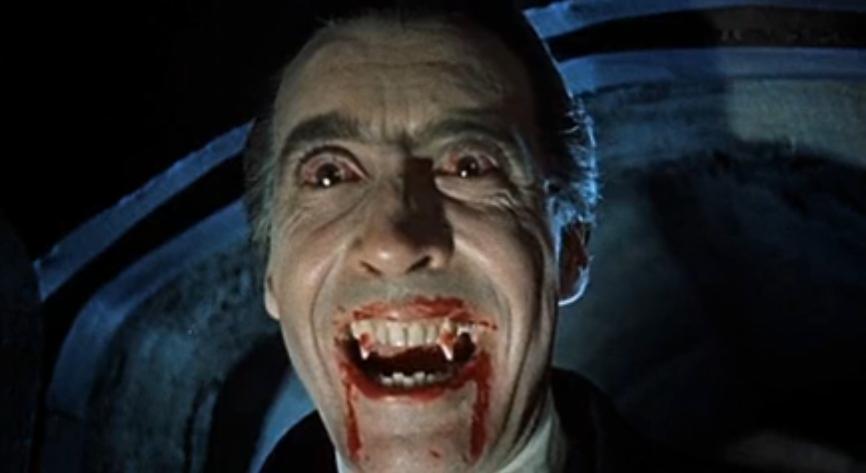
For a hundred years vampires have stalked the silver screen, capturing audiences across the world. Early works clearly drew their inspirations from key texts, such as Stoker’s Dracula and Le Fanu’s Carmilla, but later creators have turned to new perspectives, not only in the presentation of the vampire, but the meaning of the character. The vampire has been a monster, a gentleman, a lover, a tragic hero, a Satanist, a biker, a cheerleader, and a friend. It is a diverse creature that can be utilised in a myriad of ways to represent social, cultural and moral allegories, be a metaphor for death, greed, immorality, sex, and more. They are powerful, they are vulnerable, they are unnatural and they are “human.” As we have seen their powers shift, their weaknesses, their narratives, the very lore that defines them, all that remains is the need for blood to survive. A base need that should make them only monstrous, yet here we are at the end of one hundred years and still our fascination has not yet waned. Even now we have a new slew of interpretations with Vindar the Vampire (Christian corruption), The Witcher: The Vampire Hunter (based on a computer game), and Family Blood (vampirism as a drug addiction); not to mention the myriad of 21st century films (Dracula 3000, Van Helsing, Perfect Creature, BloodRayne, I Am Legend, Lesbian Vampire Killers, Vampires Suck, and so many more) I could not include in this article. Because always the vampire represents the taboo, the liminal, the dark temptation that titillates and terrifies – this is why the myths continue.
Works Cited
- Eldridge, A. (2018). Vampire: Legendary creature. Encyclopaedia Britannica. Retrieved from https://www.britannica.com/topic/vampire ↩
- Eldridge, A. (2018). Vampire: Legendary creature. Encyclopaedia Britannica. Retrieved from https://www.britannica.com/topic/vampire ↩
- Ruthner, C. (2012). Fantastic liminality. In L. Schmeink & A. Boger (Eds.), Collision of realities: Establishing research on the fantastic in Europe (p. 49). Berlin, Germany: Walter de Gruyter GmbH & Co. ↩
- Renee, V. (2017). Vampires in Film: The Cinematic Evolution of the World’s Favorite Blood-Sucker. No Film School. Retrieved from https://nofilmschool.com/2017/10/vampires-film-evolution-worlds-favorite-blood-sucker ↩
- Eldridge, A. (2018). Vampire: Legendary creature. Encyclopaedia Britannica. Retrieved from https://www.britannica.com/topic/vampire ↩
- Eldridge, A. (2018). Vampire: Legendary creature. Encyclopaedia Britannica. Retrieved from https://www.britannica.com/topic/vampire ↩
- Eldridge, A. (2018). Vampire: Legendary creature. Encyclopaedia Britannica. Retrieved from https://www.britannica.com/topic/vampire ↩
- Eldridge, A. (2018). Vampire: Legendary creature. Encyclopaedia Britannica. Retrieved from https://www.britannica.com/topic/vampire ↩
- Vampire Timeline. (2014). Vampires. Retrieved from https://www.vampires.com/vampire-timeline/ ↩
- Eldridge, A. (2018). Vampire: Legendary creature. Encyclopaedia Britannica. Retrieved from https://www.britannica.com/topic/vampire ↩
- Eldridge, A. (2018). Vampire: Legendary creature. Encyclopaedia Britannica. Retrieved from https://www.britannica.com/topic/vampire ↩
- Vampire Timeline. (2014). Vampires. Retrieved from https://www.vampires.com/vampire-timeline/ ↩
- Vampire Timeline. (2014). Vampires. Retrieved from https://www.vampires.com/vampire-timeline/ ↩
- Vampire Timeline. (2014). Vampires. Retrieved from https://www.vampires.com/vampire-timeline/ ↩
- Vampire. (n.d.). Film Affinity. Retrieved from https://www.filmaffinity.com/en/film759485.html ↩
- The first vampire film. (2014). Fright Film Geek. Retrieved from http://frightfilmgeek.blogspot.com.au/2014/11/the-first-vampire-film.html ↩
- Vampire. (n.d.). Film Affinity. Retrieved from https://www.filmaffinity.com/en/film759485.html ↩
- The first vampire film. (2014). Fright Film Geek. Retrieved from http://frightfilmgeek.blogspot.com.au/2014/11/the-first-vampire-film.html ↩
- The first vampire film. (2014). Fright Film Geek. Retrieved from http://frightfilmgeek.blogspot.com.au/2014/11/the-first-vampire-film.html ↩
- The first vampire film. (2014). Fright Film Geek. Retrieved from http://frightfilmgeek.blogspot.com.au/2014/11/the-first-vampire-film.html ↩
- Timeline. (n.d.). Evolution of the vampire genre. Retrieved from https://vampevolution.wordpress.com/about/ ↩
- Q: How is “Nosferatu” different from later vampire films? (2015). Screen Prism. Retrieved from http://screenprism.com/insights/article/how-is-nosferatu-different-from-later-vampire-films ↩
- Q: How is “Nosferatu” different from later vampire films? (2015). Screen Prism. Retrieved from http://screenprism.com/insights/article/how-is-nosferatu-different-from-later-vampire-films ↩
- Q: How is “Nosferatu” different from later vampire films? (2015). Screen Prism. Retrieved from http://screenprism.com/insights/article/how-is-nosferatu-different-from-later-vampire-films ↩
- Timeline. (n.d.). Evolution of the vampire genre. Retrieved from https://vampevolution.wordpress.com/about/ ↩
- Maloney, D. (2014). The wild evolution of vampires, from Bram Stoker to Dracula Untold. Wired. Retrieved from https://www.wired.com/2014/10/vampire-evolution/ ↩
- Maloney, D. (2014). The wild evolution of vampires, from Bram Stoker to Dracula Untold. Wired. Retrieved from https://www.wired.com/2014/10/vampire-evolution/ ↩
- Carter, I. S. (2017). There is still no better or more important Dracula than the original, Bela Lugosi. Syfy Wire. Retrieved from http://www.syfy.com/syfywire/there-is-still-no-better-or-more-important-dracula-than-the-original-bela-lugosi ↩
- Carter, I. S. (2017). There is still no better or more important Dracula than the original, Bela Lugosi. Syfy Wire. Retrieved from http://www.syfy.com/syfywire/there-is-still-no-better-or-more-important-dracula-than-the-original-bela-lugosi ↩
- Curtis Nelson, M. (2018). “Vampyr” is the best vampire movie you’ve never seen. Pop Matters. Retrieved from https://www.popmatters.com/vampyr-carl-theodore-dreyer-review-2519623319.html ↩
- Curtis Nelson, M. (2018). “Vampyr” is the best vampire movie you’ve never seen. Pop Matters. Retrieved from https://www.popmatters.com/vampyr-carl-theodore-dreyer-review-2519623319.html ↩
- Dracula Movies by Year. (2006). Dracula. Retrieved from http://dracula.cc/movies/movies_by_year/ ↩
- Dracula Movies by Year. (2006). Dracula. Retrieved from http://dracula.cc/movies/movies_by_year/ ↩
- Vampire Timeline. (2014). Vampires. Retrieved from https://www.vampires.com/vampire-timeline/ ↩
- Biscotti, S. (2016). Son of Dracula: A film about an affair, jealousy, & a famous vampire. Universal Monsters Universe. Retrieved from http://universalmonstersuniverse.com/2016/08/18/son-of-dracula-a-film-about-an-affair-jealousy-a-famous-vampire/ ↩
- Biscotti, S. (2016). Son of Dracula: A film about an affair, jealousy, & a famous vampire. Universal Monsters Universe. Retrieved from http://universalmonstersuniverse.com/2016/08/18/son-of-dracula-a-film-about-an-affair-jealousy-a-famous-vampire/ ↩
- Dracula Movies by Year. (2006). Dracula. Retrieved from http://dracula.cc/movies/movies_by_year/ ↩
- Maloney, D. (2014). The wild evolution of vampires, from Bram Stoker to Dracula Untold. Wired. Retrieved from https://www.wired.com/2014/10/vampire-evolution/ ↩
- Vampire Timeline. (2014). Vampires. Retrieved from https://www.vampires.com/vampire-timeline/ ↩
- Maloney, D. (2014). The wild evolution of vampires, from Bram Stoker to Dracula Untold. Wired. Retrieved from https://www.wired.com/2014/10/vampire-evolution/ ↩
- Pfeiffer, L. (2018). Horror of Dracula. Encyclopaedia of Britannica. Retrieved from https://www.britannica.com/topic/Horror-of-Dracula ↩
- Pfeiffer, L. (2018). Horror of Dracula. Encyclopaedia of Britannica. Retrieved from https://www.britannica.com/topic/Horror-of-Dracula ↩
- Corrigan, K. (2017). The definitive Dracula: Christopher Lee is the greatest vampire of them all. Birth. Movies. Death. Retrieved from http://birthmoviesdeath.com/2017/06/05/the-definitive-dracula-christopher-lee-is-the-greatest-vampire-of-them-all ↩
- Dracula Movies by Year. (2006). Dracula. Retrieved from http://dracula.cc/movies/movies_by_year/ ↩
- Giltinan, G. (n.d.). The Brides of Dracula. Terror Trap. Retrieved from http://www.terrortrap.com/reviews/bridesofdracula/ ↩
- Lambie, R. (2011). Looking back at “The Last Man on Earth.” Den of Geek. Retrieved from http://www.denofgeek.com/movies/17478/looking-back-at-the-last-man-on-earth ↩
- Dracula Movies by Year. (2006). Dracula. Retrieved from http://dracula.cc/movies/movies_by_year/ ↩
- Dracula Movies by Year. (2006). Dracula. Retrieved from http://dracula.cc/movies/movies_by_year/ ↩
- Corrigan, K. (2017). The definitive Dracula: Christopher Lee is the greatest vampire of them all. Birth. Movies. Death. Retrieved from http://birthmoviesdeath.com/2017/06/05/the-definitive-dracula-christopher-lee-is-the-greatest-vampire-of-them-all ↩
- Corrigan, K. (2017). The definitive Dracula: Christopher Lee is the greatest vampire of them all. Birth. Movies. Death. Retrieved from http://birthmoviesdeath.com/2017/06/05/the-definitive-dracula-christopher-lee-is-the-greatest-vampire-of-them-all ↩
- Corrigan, K. (2017). The definitive Dracula: Christopher Lee is the greatest vampire of them all. Birth. Movies. Death. Retrieved from http://birthmoviesdeath.com/2017/06/05/the-definitive-dracula-christopher-lee-is-the-greatest-vampire-of-them-all ↩
- Corrigan, K. (2017). The definitive Dracula: Christopher Lee is the greatest vampire of them all. Birth. Movies. Death. Retrieved from http://birthmoviesdeath.com/2017/06/05/the-definitive-dracula-christopher-lee-is-the-greatest-vampire-of-them-all ↩
- Corrigan, K. (2017). The definitive Dracula: Christopher Lee is the greatest vampire of them all. Birth. Movies. Death. Retrieved from http://birthmoviesdeath.com/2017/06/05/the-definitive-dracula-christopher-lee-is-the-greatest-vampire-of-them-all ↩
- Weekes, P. (2018). Hollywood’s first black vampire flick tackled the slave trade, racism and black love in 1972. The Mary Sue. Retrieved from https://www.themarysue.com/blacula-forever/ ↩
- Weekes, P. (2018). Hollywood’s first black vampire flick tackled the slave trade, racism and black love in 1972. The Mary Sue. Retrieved from https://www.themarysue.com/blacula-forever/ ↩
- Brehmer, N. (2015). Why Dracula 1979 is one of the most endearing yet unfaithful adaptations. Wicked Horror. Retrieved from http://wickedhorror.com/features/retrospectives/why-dracula-1979-is-one-of-the-most-endearing-yet-unfaithful-adaptations/ ↩
- Brehmer, N. (2015). Why Dracula 1979 is one of the most endearing yet unfaithful adaptations. Wicked Horror. Retrieved from http://wickedhorror.com/features/retrospectives/why-dracula-1979-is-one-of-the-most-endearing-yet-unfaithful-adaptations/ ↩
- Brehmer, N. (2015). Why Dracula 1979 is one of the most endearing yet unfaithful adaptations. Wicked Horror. Retrieved from http://wickedhorror.com/features/retrospectives/why-dracula-1979-is-one-of-the-most-endearing-yet-unfaithful-adaptations/ ↩
- How ‘The Lost Boys’ made vampires sexy way before ‘Buffy’ or ‘Twilight.’ (2017). Games Radar. Retrieved from https://www.gamesradar.com/lost-boys-sexy-vampires-buffy-twilight/ ↩
- Coney, B. (2017). Revisiting the messy teen vampire classic ‘The Lost Boys.’ Dazed. Retrieved from http://www.dazeddigital.com/film-tv/article/36923/1/revisiting-the-messy-teen-vampire-classic-the-lost-boys ↩
- Oler, T. (2017). Sunlight through bullet holes. Slate. Retrieved from http://www.slate.com/articles/arts/culturebox/2017/10/looking_at_kathryn_bigelow_s_vampire_western_near_dark_30_years_later.html ↩
- Oler, T. (2017). Sunlight through bullet holes. Slate. Retrieved from http://www.slate.com/articles/arts/culturebox/2017/10/looking_at_kathryn_bigelow_s_vampire_western_near_dark_30_years_later.html ↩
- My Best Friend is a Vampire. (n.d.). Revolvy. Retrieved from https://www.revolvy.com/main/index.php?s=My+Best+Friend+Is+a+Vampire&item_type=topic ↩
- My Best Friend is a Vampire. (n.d.). Revolvy. Retrieved from https://www.revolvy.com/main/index.php?s=My+Best+Friend+Is+a+Vampire&item_type=topic ↩
- My Best Friend is a Vampire. (n.d.). Revolvy. Retrieved from https://www.revolvy.com/main/index.php?s=My+Best+Friend+Is+a+Vampire&item_type=topic ↩
- Connors, G. (2015). Francis Ford Coppola’s adaption of Bram Stoker’s Dracula. Head Stuff. Retrieved from https://www.headstuff.org/literature/literature-on-film-part-1-francis-ford-coppolas-adaptation-of-bram-stokers-dracula/ ↩
- Connors, G. (2015). Francis Ford Coppola’s adaption of Bram Stoker’s Dracula. Head Stuff. Retrieved from https://www.headstuff.org/literature/literature-on-film-part-1-francis-ford-coppolas-adaptation-of-bram-stokers-dracula/ ↩
- Connors, G. (2015). Francis Ford Coppola’s adaption of Bram Stoker’s Dracula. Head Stuff. Retrieved from https://www.headstuff.org/literature/literature-on-film-part-1-francis-ford-coppolas-adaptation-of-bram-stokers-dracula/ ↩
- Sparks, C. (2014). How vampires got cool again: A pop culture timeline. Teen Vogue. Retrieved from https://www.teenvogue.com/story/coolest-vampires-in-pop-culture ↩
- McCarthy, T. (1994). Interview with a Vampire. Variety. Retrieved from http://variety.com/1994/film/reviews/interview-with-the-vampire-1200439504/ ↩
- McCarthy, T. (1994). Interview with a Vampire. Variety. Retrieved from http://variety.com/1994/film/reviews/interview-with-the-vampire-1200439504/ ↩
- Sparks, C. (2014). How vampires got cool again: A pop culture timeline. Teen Vogue. Retrieved from https://www.teenvogue.com/story/coolest-vampires-in-pop-culture ↩
- Sparks, C. (2014). How vampires got cool again: A pop culture timeline. Teen Vogue. Retrieved from https://www.teenvogue.com/story/coolest-vampires-in-pop-culture ↩
- Serrano, S. (2018). What’s great about ‘Blade.’ The Ringer. Retrieved from https://www.theringer.com/movies/2018/2/15/17015248/blade-20th-anniversary-wesley-snipes-black-panther ↩
- Macfarlane, J. M. (2016). Why the first ‘Resident Evil’ and ‘Underworld’ films are hidden Halloween treats. Nerdist. Retrieved from https://nerdist.com/why-the-first-resident-evil-and-underworld-films-are-hidden-halloween-treats/ ↩
- Macfarlane, J. M. (2016). Why the first ‘Resident Evil’ and ‘Underworld’ films are hidden Halloween treats. Nerdist. Retrieved from https://nerdist.com/why-the-first-resident-evil-and-underworld-films-are-hidden-halloween-treats/ ↩
- SDG. (n.d.). Twilight appeal: The cult of Edward Cullen and vampire love in Stephenie Meyer’s novels and the new film (2008). Decent Films. Retrieved from http://decentfilms.com/articles/twilight ↩
- The child as vampire in ‘Let the Right One In.’ (n.d.). Horror Homeroom. Retrieved from http://www.horrorhomeroom.com/vampire-child-let-right-one/ ↩
- N.A. (2013). The undead will live forever. The Economist. Retrieved from https://www.economist.com/blogs/prospero/2013/05/vampire-films ↩
- Lascala, M. (2013). ‘Byzantium’ has new vampires that play by new rules. Pop Matters. Retrieved from https://www.popmatters.com/176053-byzantium-2495714001.html ↩
- Lascala, M. (2013). ‘Byzantium’ has new vampires that play by new rules. Pop Matters. Retrieved from https://www.popmatters.com/176053-byzantium-2495714001.html ↩
- Q: Where does “Only Lovers Left Alive” fit in the tradition of vampire films. (2015). Screen Prism. Retrieved from http://screenprism.com/insights/article/what-does-this-film-do-with-the-genre-of-vampire-films ↩
- Q: Where does “Only Lovers Left Alive” fit in the tradition of vampire films. (2015). Screen Prism. Retrieved from http://screenprism.com/insights/article/what-does-this-film-do-with-the-genre-of-vampire-films ↩
- Maloney, D. (2014). The wild evolution of vampires, from Bram Stoker to Dracula Untold. Wired. Retrieved from https://www.wired.com/2014/10/vampire-evolution/ ↩
- Maloney, D. (2014). The wild evolution of vampires, from Bram Stoker to Dracula Untold. Wired. Retrieved from https://www.wired.com/2014/10/vampire-evolution/ ↩
- Kendrick, B. (2014). ‘Dracula Untold:’ Luke Evans explains what makes his Dracula different. Screen Rant. Retrieved from https://screenrant.com/dracula-untold-movie-luke-evans-interview/ ↩
- Kendrick, B. (2014). ‘Dracula Untold:’ Luke Evans explains what makes his Dracula different. Screen Rant. Retrieved from https://screenrant.com/dracula-untold-movie-luke-evans-interview/ ↩
- Gibron, B. (2014). ‘Vampire Academy’ Sucks! Pop Matters. Retrieved from https://www.popmatters.com/178921-vampire-academy-sucks-2495689126.html ↩
What do you think? Leave a comment.











I once woke up on a hot summer’s morning with two tiny streams of blood, close together, trickling from my throat. Gave me a few weird moments in front of the bathroom mirror until I realised that a mosquito had bitten me twice.
There’s nothing like the original Bram Stoker novel for making my neck itchy with fright. Or the best film adaptations of it – like Dracula with Gary Oldman as the bloodsucker.
Another great vampire story is Carmilla by Sheridan Le Fanu. I’ve never seen a film adaptation of this and am wondering if one was ever made. And if so, it’s just dying for a remake…..
I would also recommend the stories of the real Vlad Dracul and Elizabeth Bathory – guaranteed to keep you sleeping with the lights of for a fortnight at least.
Salem’s Lot. That is how the vampire should be presented. Soulless, sexless, dead and scary as hell.
I’m about halfway through Dracula at the moment and am really enjoying it. I bought it years ago but never got around to reading it. One thing I’d be interested to know is how much of the vampire myth was made up by Bram Stoker and how much came from folk stories/myths.
I think my favourite vampire film might just be Werner Herzog’s ‘Nosferatu’ remake – gorgeous, earthy, sad film.
Then there’s ‘Let The Right One In’ and I also really enjoy ’30 Days of Night’ for some reason. Have to love the various Hammer Dracula flicks too.
It doesn’t have proper vampires, but Jean Rollin’s ‘Fascination’ is an awesome, erotic film about an all female blood drinking cult.
Let the Right One In by John Ajvide Lindqvist is a good contemporary take on the vampire story.
I agree. Also, the film adaptation is pretty well done. The SWEDISH one, I mean. There’s also a movie out with the title “Let me in”, if I remember correctly, which is “the US version” of the Swedish one… Not to repeat the “stupid American remakes”-chorus, but I prefer the “original” movie adaptation…
Most of my favourite vampire films have already been mentioned in the article. but I’d like to add Daybreakers to the list. Nothing revolutionarily new about the vampire motif, but quite a nice film…
I thought that was a wasted concept, personally. Very disappointing. Straight-to-DVD fare that somehow got released …
I remember seeing Polanski’s Dance of the Vampires as a kid. My parents let me watch it cause it was a comedy… to them! I was terrified for weeks.
Love this film and the snowy visuals.
Article came out great!
There is a name that hasn’t been mentioned yet. That of Montague Summers. A man who sincerely believed in the occult, including vampires, and took them seriously in a cynical age. He was a contemporary of Aleister Crowley, and if Crowley posed as a satanist Summers posed as a witch-finding undead-hunting Roman Catholic clergyman. A kind of Father Brown- Vampire Hunter. Whether or not he was actually a priest is uncertain.
Best vampire film? Well, I love Near Dark, The Lost Boys, Bram Stoker’s Dracula and 30 Days of Night amongst others, but it’s got to be Duck ‘Til Dawn surely.
What about ‘Vampires in Havana’, has anybody seen it? A Cuban adult-oriented animated film with trumpet performances by Arturo Sandoval. I vaguely remember having watched it ages ago.
Great history of vampires. The late Hammer film ‘Captain Kronos: Vampire Hunter’ is good fun. Written and directed by ‘The Avengers’ scriptwriter Brian Clemens, and it shows.
I’d recommend:
Vampire Hunter D: Bloodlust and Thirst (2009).
The Twilight crap looks so bloody dull! I have no time for the moping of a Mary Sue and her sullen stalker.
Most interesting vampire novel from a literature-lover’s point of view is Tim Powers’s The Stress Of Her Regard – it has Byron & Co. involved in a frightening vampire affair (a real femme fatale being involved). Powers was inspired by the old Greek tradition of the lamia.
I like Tim Powers a great deal, but better yet is Tom Holland’s ‘secret history’ novels which include Sleeper in the Sands (Ahknaten as alien vampire), The Vampyre (Byron and Polidori the…well vampire), Supping with Panthers, Lord of the Dead and the simply brilliant Deliver Us From Evil which includes The 2nd Earl of Rochester and the Golem. He seems to have given up on fiction in favour of writing excellent factual history books, butall his scholarship is brilliantly used in his novels.
And what about George R. R. Martin’s superb match of Southern Gothic and Vampire legend Fevre Dream? Fantastic book.
Kim Newman’s series of Dracula novels (Anno Dracula, The Bloody Red Baron and Dracula Cha-Cha-Cha) are highly entertaining reads as put Newman’s terrific knowledge of the genre to good us.
What is life without vampires? Great rundown. I’d recommend Cjristopher Golden and Mike Mignola’s Baltimore or the Steadfast Tin Soldier and the Vampire. Set in a fascinating world were WWI was brought to apremature end by plague and the survivors now face the threat of a vampire menace re-awakened by the titular character, Lord Baltimore, it’s one of the most beautiful books printed in recent years.
I’d recommend Dracula The Undead by Dacre Stoker. It is the first story to be supported by the Stoker estate and as the author’s name shows, is written by a direct descendant of Stoker. It picks up where Dracula left off and features Dr Seward and the son of Mina and Jonathan Harker. An interesting take and a good addition to the genre.
I love Salem’s Lot and I am Legend. SPOILERS: good examples of how the main characters don’t always make it through alive!
I’m a fan of Salem’s Lot. I think it’s a book that actually expresses quite a lot of my thinking: the vampire itself has very little substance, just a partasite. What’s important are the elements it draws out of the people around it. I do also enjoy Kim Newman’s Anno Dracula series, largely because of the genre-fan trainspotting element. I admit, I haven’t read Twilight.
If we’re talking books the best vampires are the ones in Carpe Jugulum; Count Magpyr and his appalling family and hangers-on, The Fifth Elephant; Lady Margolotta, with her pearls and bat decorated twin set, and The Truth; Otto Chriek, photographer and black-ribboner, who carries a file of blood for when the flash turns him to dust. All wonderful inventions by Terry Pratchett.
If we’re talking film then Spike in Buffy the Vampire Slayer is god.
First off, great job compiling this piece.
One thing that struck me about contemporary vampires, and I think the Cullens are a perfect example of this, is how often their stories revolve around the theme of abstinence – usually from blood-sucking but also often from sex as well. The idea of the vampire going against his nature by not consuming humans keeps cropping up. Just off the top of my head I can think of a number of storylines from Buffy, Anne Rice’s Vampire Chronicles, Being Human, the Sookie Stackhouse series / True Blood, etc. I can’t imagine Dracula feeling such qualms about his victims.
It feels like there’s a strong impulse to tame the vampire in modern interpretations; to keep all his attractive qualities – his beauty, charm, power, erudition, etc., but get rid of the inconvenient fact that he eats people! He’s become an idealised fantasy figure instead of a monster. The best stories play on this tension between the fantasy and the monstrosity but I felt in Twilight the de-fanging had gone too far. Honestly, the book started to feel like one long mantra – Bella is awkward, Edward is beautiful; Bella is awkward, Edward is beautiful, repeat ad infinitum!
(Random aside – as I just noticed I keep referring to the vampire as ‘he’ – it’s interesting that the term ‘vamp’ is used to refer to a sexually powerful but potentially threatening woman yet nearly the iconic vampires, from Dracula to Edward Cullen, are male.)
If you subscribe to the idea that Bram Stoker’s vampires represented a fear of sexuality in a very sexually repressed society then it makes sense that this aspect tends to be played down in modern vampire stories. Although we’re arguably just as obsessed with sex as the Victorians we’re generally nowhere near as repressed; so modern-day vampires are more beautiful than their Victorian counterparts but much less seductive. It’s just a theory but I wonder whether contemporary vampire stories reflect society’s fears over drug addiction rather than sex; so the abstinent vampire reflects the heroin addict trying to quit but under constant temptation and it’s this out-of-control addict/vampire which is seen to pose the threat to social stability.
A great vampire story is by the 19th century French pulp novelist Paul Feval- “Vampire City”- it was written about 20 years before Stoker’s “Dracula” and features Anne Radcliffe, attractive young novelist and vampire hunter. It is definitely tongue in cheek in the way it piles weirdness upon weirdness- a satire on the whole Gothic writing thing, and totally over the top.
Elizabeth Knox, Daylight: stunning!
Vampires are mythical creatures. An author can interpret them how they wish. What they represent has changed a great deal over time. They used to be a metaphor for plague. Most people would not even recognise “I Am Legend” as a vampire book nowadays, because zombies more commonly fit that role.
I suspect most people get annoyed by Twilight because Meyer took a horror trope and relocated it to teen romance. To be fair, horror had largely abandoned it. Pretty much every horror magazine had “No vampires” in their submissions guidelines for most of ’90’s.
I’ve got to confess. I read Stephanie Meyer’s Twilght. Then, I read the other three Twilight books within the same week. Talk about literary crack. No, I didn’t find the young adult novel Twilight well-written, it really drags in places (oh, the fantastic chore ride!), and any suspense is two minutes out of an hour (most the book’s chapters should be entitled How to Deal With Your Vampire Boyfriend’s Wild Mood Swings). Still, it’s a solid love story derived from a classic premise: ‘Ugly’ duckling Bella becomes a ‘swan’ when true love conquers all.
The Twilight vampires, like so many of their contemporaries, seem to have been infected with an acute case of Dawsonitis and spend most of their time agonising over or apologising for their vampirism. They’ve managed to make being an immortal, immensely strong, beautiful, powerful creature seem decidedly joyless. I suppose, in a way, it makes them more human/humane but it really does dilute the horror. If I absolutely had to be bled dry by a blood-sucking fiend, I’d like to think that his heart was in it at least!
Fang-fans might like to try “Mrs. Ames” a wonderful vamp short story by EF Benson, the author of the Mapp and Lucia series. Another of Benson’s short stories, “The Room In the Tower” is quite one of the creepiest stories I’ve ever read – I defy anyone to read it at night on their own and not have the shudders… it has strong vampire overtones.
I think it’s interesting to see how the vampire, has been remodelled over the years to suit and reflect the current twists and turns of society. Before film, the vampire only really existed as words (although there were more than enough words to give a very good description) but words only do so much. The gaps are filled in by our imaginations. (Which is one of the great things about reading books and listening to radio plays – i.e. our brains are much more engaged with the story telling process.)
Then the talkies came along and provided us with a set of images and ideas that haven’t really changed much since Nosferatu. Hammer films refined the image with several subtle variations, which were reflected in Interview With The Vampire, which with its enormous budget was able to go all out for glamour, I’m happy to say.
As for their powers and weaknesses, that’s another set of ideas that seem to ebb and flow. What doesn’t seem to change (much) is the sex of the main character, the supreme vampire in the colony is nearly always male – the females being there largely for audience titillation and cheap thrills. In my own take on the vampire, The Darkness Beneath, the main protagonist is a female who lives in the London Underground. This is not the normal luxurious setting: it shows that we live in difficult times and have to cut our cloth accordingly.
It will be fascinating to see the path vampires, who achieve immortality not through drinking blood but through books and films, take as society weaves it’s way through the next decade or two. What sort of beast will appear in a world ravaged by climate change, or a society dealing the collapse of capitalism, or both?
What wonderful film references! Very excited to watch them.
I think it is great exemplification about the legend of the vampire in Cinemas. I think ones I would add are definitely Interview with A Vampire and Queen of the Damned. Anne Rice was important in the vampire novel world and the films I would say are too, not the greatest films of all time but definitely add something to the conversation.
I really loved reading this article on Cinematic Vampires, it was an interesting read that had me hooked from the beginning. Reading this has made me realise that there are so many movies about vampires that I haven’t yet watched such as; Nosferatu Blade, My Best Friend is a Vampire and the Dracula movies. I am now really keen to watch them, and see the different characteristics of vampires and how they’re portrayed in different movies throughout history as shown in this article.
An extremely thorough analysis. Fright Night, a 1985 vampire comedy, may also be worth a second look.
Excellent overview of the cinematic history of the vampire! Also a great analysis of showing how the mythos of the vampire has changed overtime while still paying tribute to its origins.
Really interesting read! I’m a huge fan of all vampire movies, but didn’t know the history behind them.
Brilliant! Ever since I read Stoker’s Dracula I fell in love with vampires and how they have been used in popular culture to symbolise the luring threats of the unknown.
I am always thrilled when I can find out more about them.
Today, Count Dracula will now be the ultimate vampire stripper for women.
Great job here! I can tell a lot of research went into this. My only minor suggestion would be more paragraph breaks, but I love how you chronicled the progression of vampire films. You encapsulated it well here: “As part of this they have often been associated with concepts of taboo or liminality.”
Loved, loved, loved this article. Just very thorough and detailed in research and impact of each film/novel. I remember reading Carmilla for my Irish Lit class and grimacing whenever I attempt to compare it with vampire academy or twilight. I have a lot of respect for the books/films that have incorporated this creature and affirmed immortality *pun intended*. I agree that it also speaks a lot for pop culture and how it progresses, and how time affects the narrative of the vampire. I look forward to watching all these movies now! Great article.
An interesting essay. A good overview of various films, most I’ve seen so I enjoyed how you discussed them.
It’s beyond me how articles about the history of vampires in media always forget the BBC series starring Louis Jourdan as the FIRST SEXY VAMPIRE. The series was a sensation when it was first shown. Needs to be made public again.
The early vampire seems to share similarities with the succubus/incubus.
Interesting discussion… one of the things that’s always struck me about some of the more recent films, e.g. LET THE RIGHT ONE IN, is how they start to encourage empathy for these vampiric figures… also the recent pivot to using it as a comedic tool e.g. WHAT WE DO IN THE SHADOWS